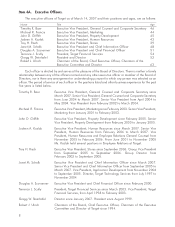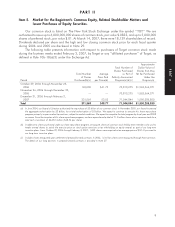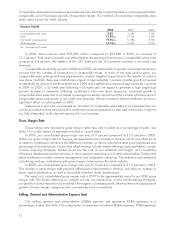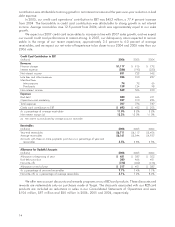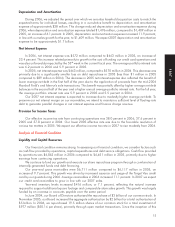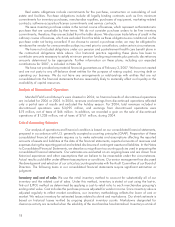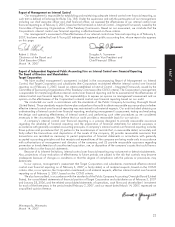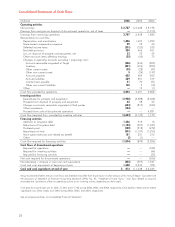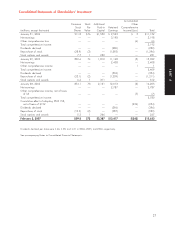Target 2006 Annual Report Download - page 36
Download and view the complete annual report
Please find page 36 of the 2006 Target annual report below. You can navigate through the pages in the report by either clicking on the pages listed below, or by using the keyword search tool below to find specific information within the annual report.Real estate obligations include commitments for the purchase, construction or remodeling of real
estate and facilities. Purchase obligations include all legally binding contracts such as firm minimum
commitments for inventory purchases, merchandise royalties, purchases of equipment, marketing-related
contracts, software acquisition/license commitments and service contracts.
We issue inventory purchase orders in the normal course of business, which represent authorizations to
purchase that are cancelable by their terms. We do not consider purchase orders to be firm inventory
commitments; therefore, they are excluded from the table above. We also issue trade letters of credit in the
ordinary course of business, which are excluded from this table as these obligations are conditional on the
purchase order not being cancelled. If we choose to cancel a purchase order, we may be obligated to
reimburse the vendor for unrecoverable outlays incurred prior to cancellation, under certain circumstances.
We have not included obligations under our pension and postretirement health care benefit plans in
the contractual obligations table above. Our historical practice regarding these plans has been to
contribute amounts necessary to satisfy minimum pension funding requirements plus periodic discretionary
amounts determined to be appropriate. Further information on these plans, including our expected
contributions for 2007, is included in Note 28.
We have not provided any material financial guarantees as of February 3, 2007. We have not created
and are not party to any off-balance sheet entities for the purpose of raising capital, incurring debt or
operating our business. We do not have any arrangements or relationships with entities that are not
consolidated into the financial statements that are reasonably likely to materially affect our liquidity or the
availability of capital resources.
Analysis of Discontinued Operations
Marshall Field’s and Mervyn’s were divested in 2004; no financial results of discontinued operations
are included for 2006 or 2005. In 2004, revenues and earnings from discontinued operations reflected
only a partial year of results and excluded the holiday season. For 2004, total revenues included in
discontinued operations were $3,095 million, and earnings from discontinued operations were
$75 million, net of taxes of $46 million. In addition, we recorded a gain on the sale of discontinued
operations of $1,238 million, net of taxes of $761 million, during 2004.
Critical Accounting Estimates
Our analysis of operations and financial condition is based on our consolidated financial statements,
prepared in accordance with U.S. generally accepted accounting principles (GAAP). Preparation of these
consolidated financial statements requires us to make estimates and assumptions affecting the reported
amounts of assets and liabilities at the date of the financial statements, reported amounts of revenues and
expenses during the reporting period and related disclosures of contingent assets and liabilities. In the Notes
to Consolidated Financial Statements, we describe our significant accounting policies used in preparing the
consolidated financial statements. Our estimates are evaluated on an ongoing basis and are drawn from
historical experience and other assumptions that we believe to be reasonable under the circumstances.
Actual results could differ under different assumptions or conditions. Our senior management has discussed
the development and selection of our critical accounting estimates with the Audit Committee of our Board of
Directors. The following items in our consolidated financial statements require significant estimation or
judgment:
Inventory and cost of sales We use the retail inventory method to account for substantially all of our
inventory and the related cost of sales. Under this method, inventory is stated at cost using the last-in,
first-out (LIFO) method as determined by applying a cost-to-retail ratio to each merchandise grouping’s
ending retail value. Cost includes the purchase price as adjusted for vendor income. Since inventory value is
adjusted regularly to reflect market conditions, our inventory methodology reflects the lower of cost or
market. We reduce inventory for estimated losses related to shrink and markdowns. Our shrink estimate is
based on historical losses verified by ongoing physical inventory counts. Markdowns designated for
clearance activity are recorded when the salability of the merchandise has diminished. Inventory is at risk of
18


